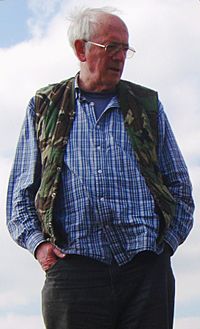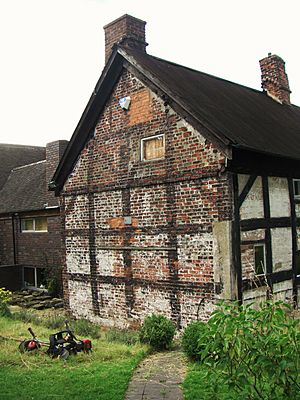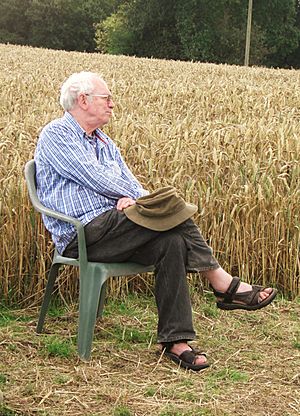Alan Garner facts for kids
Quick facts for kids
Alan Garner
OBE FRSL
|
|
|---|---|

Garner in 2011
|
|
| Born | 17 October 1934 Congleton, Cheshire, England |
| Occupation |
|
| Period | 1960–present |
| Genre | Children's fantasy, low fantasy, folklore |
| Notable works | |
| Notable awards | Carnegie Medal 1967 Guardian Prize 1968 |
| Spouse | Griselda Garner (m. 1972) |
| Signature | |
 |
|
Alan Garner OBE FRSL (born 17 October 1934) is a famous English writer. He is best known for his exciting fantasy novels for young people. He also retells old British folk tales. Much of his writing is inspired by the land, history, and stories of his home county, Cheshire, in North West England. His books often take place there and use words from the local Cheshire dialect.
Garner was born in Congleton and grew up in Alderley Edge. He spent a lot of time in a wooded area called "The Edge." This is where he first became interested in the old stories of the area. After studying at Manchester Grammar School and briefly at Oxford University, he moved to Blackden in 1957. He bought and fixed up an old building from around 1590 called Toad Hall. His first novel, The Weirdstone of Brisingamen, came out in 1960. It was a fantasy story for children set on The Edge. It used local folk tales in its plot and characters. Garner wrote a sequel, The Moon of Gomrath (1963), and a third book, Boneland (2012). He also wrote other fantasy novels, like Elidor (1965), The Owl Service (1967), and Red Shift (1973).
Later, Garner wrote books that were less about fantasy. He created The Stone Book Quartet (1979). This was a series of four short stories. They showed a day in the life of four different generations of his family. He also published collections of British folk tales he had rewritten. These included Alan Garner's Fairy Tales of Gold (1979) and A Bag of Moonshine (1986). In his later novels, Strandloper (1996) and Thursbitch (2003), he continued to write stories about Cheshire. These books did not have the fantasy parts of his earlier work.
Contents
- About Alan Garner's Life
- Early Years and Education: 1934–1956
- First Novels: The Weirdstone of Brisingamen and The Moon of Gomrath (1957–1964)
- Later Fantasy Novels: Elidor, The Owl Service, and Red Shift (1964–1973)
- The Stone Book Series and Folk Tale Collections (1974–1994)
- Later Works: Strandloper, Thursbitch, Boneland, Where Shall We Run To?, and Treacle Walker (1996–Present)
- Alan Garner's Personal Life
- Alan Garner's Writing Style
- How Alan Garner is Recognized
- Books, TV, and Radio Adaptations
- Alan Garner's Books
- See also
About Alan Garner's Life
Early Years and Education: 1934–1956
Alan Garner was born in Congleton, Cheshire, on 17 October 1934. He grew up in Alderley Edge, a village near Manchester. His family had lived in Alderley Edge since at least the 1500s. Garner said his family shared "real oral traditions." These were folk tales about The Edge. They included stories of a king and his knights sleeping under the hill, guarded by a wizard. In the mid-1800s, Alan's great-great-grandfather, Robert, carved a wizard's face into a cliff near a well. This well was known as the Wizard's Well.
Garner's family members were all skilled craftspeople. His grandfather, Joseph Garner, taught him the folk tales he knew about The Edge. Garner said he felt the "magic" of The Edge as a child. He and his friends often played there. The story of the king and wizard under the hill was very important to him. It deeply influenced his later novels.
As a child, Garner was often sick and had to stay in bed. He went to a local village school. There, he was praised for being smart. But he was punished for speaking in his local Cheshire dialect. For example, when he was six, his teacher washed his mouth out with soap. Garner then earned a place at Manchester Grammar School. His school fees were waived because of his family's income. He was very good at sprinting there. He sometimes jogged with the mathematician Alan Turing. They both loved the Disney film Snow White and the Seven Dwarfs. After school, Garner served in the Royal Artillery during his national service.
Garner became very interested in Ancient Greek language and writers like Aeschylus and Homer. He decided to study Classics at Magdalen College, Oxford. He passed his entrance exams in January 1953. He was the first in his family to go to university. He felt this separated him from his family. In 1955, he joined the university's theater group. He played Mark Antony in a play by William Shakespeare. In August 1956, he decided to become a novelist. He left Oxford later that year without finishing his degree. He felt that the strict way of thinking he learned at university helped him throughout his life.
First Novels: The Weirdstone of Brisingamen and The Moon of Gomrath (1957–1964)
When he was 22, Garner found an old house called Toad Hall for sale. It was a very old building in Blackden, near Alderley Edge. He bought it in June 1957 with money borrowed from a local group. He fixed up the house, turning two small cottages back into one home.
Garner started writing his first novel, The Weirdstone of Brisingamen: A Tale of Alderley, in September 1956. He finished it at Toad Hall. The story is set in Alderley Edge. It's about two children, Susan and Colin. They go to live with their mother's old nursemaid, Bess, and her husband, Gowther Mossock. While exploring The Edge, they meet evil creatures called svart alfar. These creatures live in the old mines and want to capture the children. The wizard Cadellin saves them. He tells them that dark forces are gathering at The Edge. They are looking for a powerful magic item, the "weirdstone of Brisingamen."
While writing in his free time, Garner tried to be a teacher. But he soon quit, feeling he could not write and teach at the same time. Instead, he worked as a general laborer for four years. He was unemployed for much of that time.
Garner sent his first novel to the publisher Collins. The head of the company, Sir William Collins, was looking for new fantasy novels. This was because J. R. R. Tolkien's The Lord of the Rings had been very successful. The Weirdstone of Brisingamen was published in 1960. It was a success with critics and readers. It was later called a "tour de force of the imagination." This means it was a very impressive and powerful story.
After his first book was published, Garner stopped working as a laborer. He became a freelance television reporter. He also started writing a sequel to The Weirdstone of Brisingamen. This book was called The Moon of Gomrath. It also follows Colin and Susan's adventures. Susan becomes possessed by an evil creature called the Brollachan. With the wizard Cadellin's help, the Brollachan is removed. But Susan's soul goes to another dimension. Colin must find a way to bring it back. Garner later wrote a third book, Boneland, which came out in August 2012.
Later Fantasy Novels: Elidor, The Owl Service, and Red Shift (1964–1973)
In 1962, Garner began working on a radio play called Elidor. This eventually became a novel. Elidor is set in Manchester. It tells the story of four children who find a portal to a magical world called Elidor in an old church. In Elidor, King Malebron asks them to help save four treasures. Evil forces have stolen them and want to take over the kingdom. The children succeed and return to Manchester with the treasures. But the evil forces follow them.
Before writing Elidor, Garner saw a dinner service set. It could be arranged to show pictures of either flowers or owls. This design inspired his fourth novel, The Owl Service. This story was greatly influenced by an old Welsh tale called Math fab Mathonwy. The book was highly praised. It won both the Carnegie Medal and the Guardian Children's Fiction Prize. People also started discussing if Garner should be called a children's writer. This book seemed good for adults too.
It took Garner six years to write his next novel, Red Shift. This book focuses on three love stories that are connected. One is set in the present day. Another is during the English Civil War. The third is in the second century CE. One expert called Red Shift a "difficult book" for new readers. Its main ideas are "loneliness and not being able to communicate." However, reading it many times shows it is a very realistic story. It has more depth and believable characters than many other "realistic" young adult novels.
The Stone Book Series and Folk Tale Collections (1974–1994)
From 1976 to 1978, Garner published four short novels. They are known as The Stone Book quartet. These books are The Stone Book, Granny Reardun, The Aimer Gate, and Tom Fobble's Day. Each book focuses on one day in the life of a child from a different generation of the Garner family.
Garner said that writing The Stone Book Quartet was "exhausting" but also "the most rewarding" thing he had done. He pays close attention to language in his books. He tries to capture the sound of the Cheshire way of speaking in modern English.
In 1981, a literary expert named Neil Philip wrote a book about Garner's novels called A Fine Anger. Philip said that The Stone Book quartet was a turning point in Garner's writing.
Later Works: Strandloper, Thursbitch, Boneland, Where Shall We Run To?, and Treacle Walker (1996–Present)
In 1996, Garner's novel Strandloper was published.
In 1997, he wrote The Voice That Thunders. This book is a collection of essays and talks. It includes many stories about his own life. It also shares his thoughts on folklore, language, literature, and myths. In this book, he talked about how publishers wanted him to write more sequels to his earlier books. He felt that making series would "make the existing work useless." He believed it would also "bring about my artistic and spiritual death." He felt he could not do this.
Garner's novel Thursbitch was published in 2003.
The novel Boneland came out in 2012. It completed a trilogy that began 50 years earlier with The Weirdstone of Brisingamen.
In August 2018, Garner published his first memoir, Where Shall We Run To?. It describes his childhood during the Second World War.
His novel Treacle Walker was published in October 2021. It was nominated for the 2022 Booker Prize.
In October 2024, just before his 90th birthday, Garner published a second memoir. It is called Powsels and Thrums. This book has short essays about different people and events in Garner's life. It covers from when he started at Manchester Grammar in 1946 to when he discovered Alderley Edge in the 1950s. It also includes poems.
Alan Garner's Personal Life
With his first wife, Ann Cook, Alan Garner had three children. In 1972, he married Griselda Greaves. She was a teacher and a critic. They had two children together. Garner has said that he does not spend time with other writers. He prefers to be friends with archaeologists.
Alan Garner's Writing Style
Even though Garner's early books are often called "children's literature," he does not agree with this. He has said that he has "never written for children." Instead, he writes only for himself. One expert, Neil Philip, said that Garner's books are enjoyed by certain types of people, no matter their age. Garner believes that a child's point of view helps him see the world freshly. Children are still discovering the universe, while many adults are not.
Philip also said that Garner's writing tries to make complex ideas simple. He tries to explain abstract ideas in clear, real ways. Garner's work is also very personal. It includes parts of his own life in both clear and hidden ways. His books use myths and folk tales to explore the feelings and challenges of the 20th century. Philip also noted that "Time is Garner's most consistent theme."
Another author, Catherine Butler, said that Garner pays close attention to the history of the places in his books. He makes sure his stories fit with the real world. For example, he included maps of Alderley Edge in The Weirdstone of Brisingamen and The Moon of Gomrath. Garner spends a lot of time researching the areas he writes about. He once said that to write Elidor, he had to read many textbooks. These included books on physics, Celtic symbols, and ancient archaeology. He also studied the writings of Jung and visited important places.
How Alan Garner is Recognized
One expert, Maria Nikolajeva, called Garner "one of the most controversial" authors in modern children's literature.
In 2010, for the 50th anniversary of The Weirdstone of Brisingamen, many famous British fantasy writers praised Garner. Susan Cooper said his talent has grown with every book. David Almond called him one of Britain's "greatest writers." Philip Pullman, who wrote the His Dark Materials trilogy, said Garner is the most important British fantasy writer since Tolkien. He even said Garner is better than Tolkien in many ways. Pullman believes Garner is a "great originator" and "deeper and more truthful."
Another fantasy writer, Neil Gaiman, said Garner's stories are "something special." He said they are "smart and challenging." They are set in real English places that come alive with folklore. People in his books find themselves living and fighting through myths. Nick Lake, an editor at HarperCollins Children's Books, called Garner "one of the greatest and most influential writers this country has ever produced." Emma Donoghue remembered reading Red Shift as a teenager. She said it "shook me to my core every time I read it." She added that Garner makes the past feel "terrifyingly real."
Awards and Honors
The Hans Christian Andersen Award is a very important award for children's book writers. Garner was the runner-up for the writing award in 1978.
He was given the Officer of the Order of the British Empire (OBE) honor in 2001 for his contributions to literature. He also received the Karl Edward Wagner Award in 2003. In 2012, he won the World Fantasy Award for Life Achievement. In January 2011, the University of Warwick gave him an honorary degree. He has also received honorary doctorates from the University of Salford (2011) and the University of Huddersfield (2012). He became a Fellow of the Royal Society of Literature in 2012.
He has won several awards for specific books:
- The Owl Service (1967) won both the Carnegie Medal and the Guardian Children's Fiction Prize.
- The Weirdstone of Brisingamen (1960) was added to the Lewis Carroll Shelf Award list in 1970. This meant it belonged on the same shelf as Alice in Wonderland.
- The Stone Book (1976) won the 1996 Phoenix Award. This award is for the best English children's book that did not win a major award when it was first published.
- His novel Treacle Walker was shortlisted for the 2022 Booker Prize. This made Garner the oldest writer nominated at that time.
Books, TV, and Radio Adaptations
Many of Alan Garner's works have been adapted for different media:
- The Weirdstone of Brisingamen was made into a 6-part radio play for the BBC in November 1963.
- Elidor was read in parts on the BBC's Jackanory program in June 1968.
- The Owl Service (1969) was a British TV series based on his novel.
- A second radio adaptation of Elidor was broadcast on BBC Radio 4 in July 1972.
- Red Shift (BBC, 1978) was a TV play.
- To Kill a King (1980) was part of a BBC series about supernatural themes.
- The Keeper (ITV, 1983) was an episode of the children's series Dramarama: Spooky.
- Garner and Don Webb adapted Elidor into a BBC children's TV series in 1995. It had six episodes.
- The Owl Service was adapted for the stage in 2004 in Plymouth.
- Elidor was made into a four-part radio play by Don Webb. It was broadcast on BBC Radio 4 Extra in 2011.
Alan Garner's Books
Novels
|
Short Story Collections
|
Other Books
|
See also
 In Spanish: Alan Garner para niños
In Spanish: Alan Garner para niños



